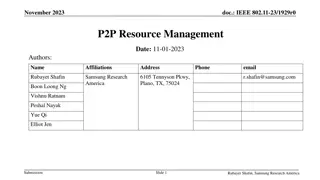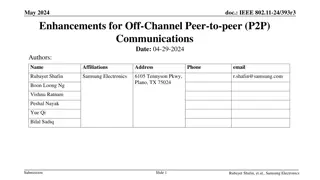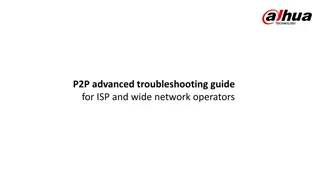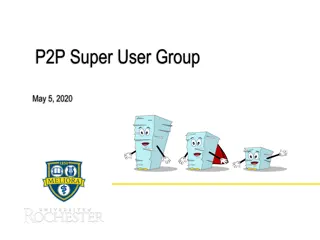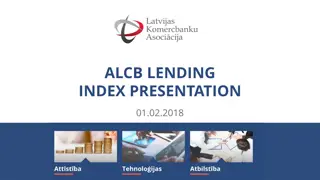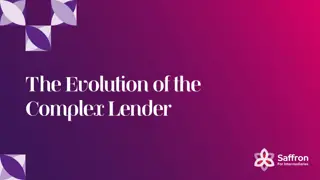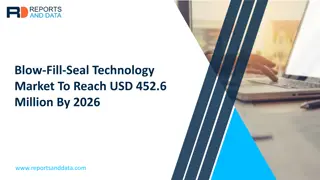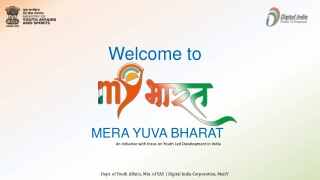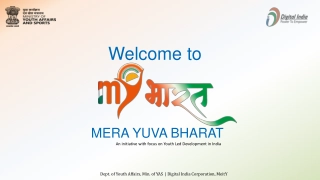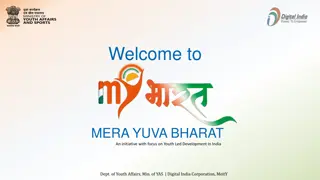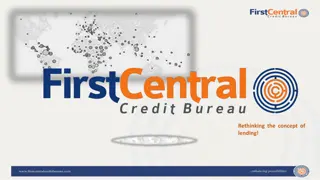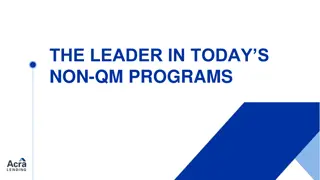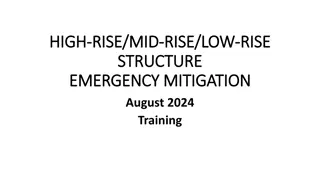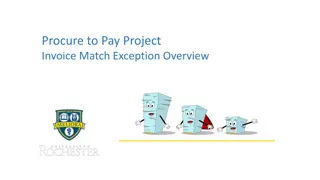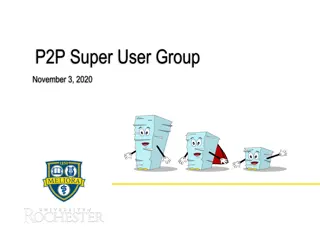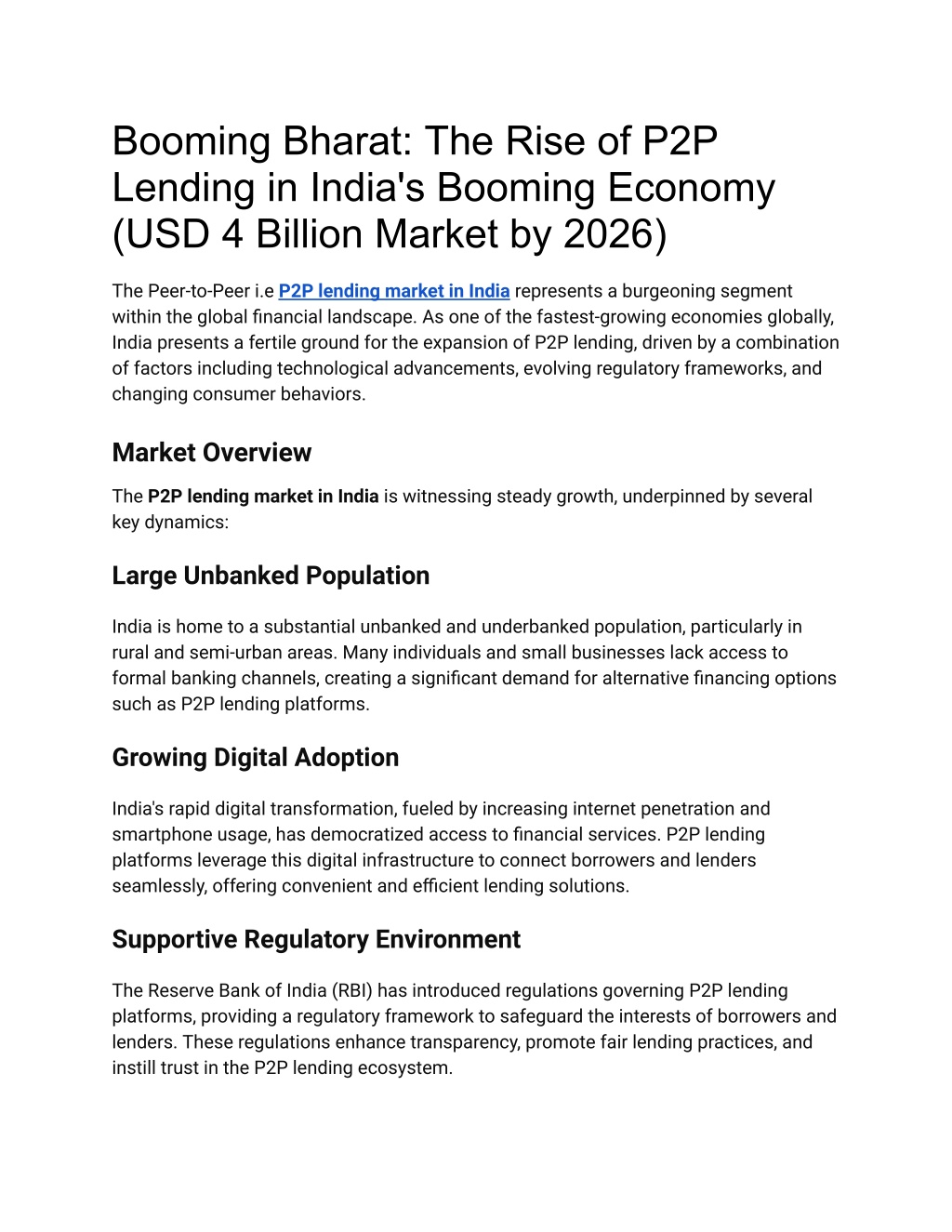
Booming Bharat The Rise of P2P Lending in India's Booming Economy (USD 4 Billion Market by 2026)
The Peer-to-Peer i.e P2P lending market in India represents a burgeoning segment within the global financial landscape. As one of the fastest-growing economies globally, India presents a fertile ground for the expansion of P2P lending, driven by a combination of factors including technological advancements, evolving regulatory frameworks, and changing consumer behaviors.n
- p2p lending market size india
- india p2p lending market
- p2p lending market in india
- p2p lending market size
- p2p lending market share
- p2p lending market
Download Presentation

Please find below an Image/Link to download the presentation.
The content on the website is provided AS IS for your information and personal use only. It may not be sold, licensed, or shared on other websites without obtaining consent from the author. Download presentation by click this link. If you encounter any issues during the download, it is possible that the publisher has removed the file from their server.
E N D
Presentation Transcript
Booming Bharat: The Rise of P2P Lending in India's Booming Economy (USD 4 Billion Market by 2026) The Peer-to-Peer i.e P2P lending market in India represents a burgeoning segment within the global financial landscape. As one of the fastest-growing economies globally, India presents a fertile ground for the expansion of P2P lending, driven by a combination of factors including technological advancements, evolving regulatory frameworks, and changing consumer behaviors. Market Overview The P2P lending market in India is witnessing steady growth, underpinned by several key dynamics: Large Unbanked Population India is home to a substantial unbanked and underbanked population, particularly in rural and semi-urban areas. Many individuals and small businesses lack access to formal banking channels, creating a significant demand for alternative financing options such as P2P lending platforms. Growing Digital Adoption India's rapid digital transformation, fueled by increasing internet penetration and smartphone usage, has democratized access to financial services. P2P lending platforms leverage this digital infrastructure to connect borrowers and lenders seamlessly, offering convenient and efficient lending solutions. Supportive Regulatory Environment The Reserve Bank of India (RBI) has introduced regulations governing P2P lending platforms, providing a regulatory framework to safeguard the interests of borrowers and lenders. These regulations enhance transparency, promote fair lending practices, and instill trust in the P2P lending ecosystem.
Market Size and Share The Indian P2P lending market is poised for significant expansion, with robust growth projected in the coming years: Market Size Projections Estimates indicate that the P2P lending market in India could surpass USD 4 billion by 2026, with a projected compound annual growth rate (CAGR) exceeding 8% between 2021 and 2026. This growth trajectory underscores the increasing popularity of P2P lending platforms as viable alternatives to traditional banking channels. Market Share Dynamics While India's P2P lending market share remains relatively modest compared to established markets, such as China and the United States, it exhibits promising growth potential. As awareness about P2P lending platforms grows and regulatory clarity improves, the market is expected to attract a more significant share of borrowers and investors. Growth Drivers Several factors are driving the growth of the lending market in India: Demand from SMEs and Consumers Small and medium enterprises (SMEs) and individual borrowers are increasingly turning to P2P lending platforms to fulfill their financing needs. P2P lending offers faster loan approvals, competitive interest rates, and flexible borrowing terms, making it an attractive option for borrowers seeking hassle-free access to credit. Technological Advancements P2P lending platforms leverage advanced technologies, including artificial intelligence and machine learning, to automate credit assessments, streamline loan processing, and enhance risk management practices. These technological innovations improve operational efficiencies and enhance the overall borrower experience.
Government Initiatives The Indian government's initiatives to promote financial inclusion and digital payments have created a conducive environment for the growth of P2P lending. Policies aimed at expanding access to credit and fostering entrepreneurship align with the objectives of P2P lending platforms, driving adoption and market penetration. Challenges and Opportunities Despite its growth prospects, the market faces certain challenges: Regulatory Uncertainty The evolving regulatory landscape poses challenges for P2P lending platforms, requiring them to adapt to changing compliance requirements and regulatory expectations. Clarity and consistency in regulations are essential to ensure the long-term sustainability and credibility of the P2P lending industry. Risk Management Effective risk management remains a priority for P2P lending platforms, given the inherent risks associated with unsecured lending. Implementing robust credit assessment mechanisms, ensuring borrower authenticity, and maintaining adequate loan loss reserves are critical to mitigate credit risks and protect investor interests. Investor Education Enhancing investor awareness and education is essential to foster confidence in the P2P lending market. Educating investors about the risks and rewards of P2P lending, promoting responsible investment practices, and providing transparent disclosure of investment opportunities can help build a resilient and vibrant P2P lending ecosystem. Conclusion The P2P lending market in India represents a dynamic and evolving landscape, offering a viable alternative to traditional banking channels. With the right regulatory framework, technological innovation, and investor confidence, P2P lending has the potential to drive financial inclusion, stimulate economic growth, and empower borrowers and investors alike.
FAQs Q1. Are P2P lending platforms regulated in India? Answer: Yes, the Reserve Bank of India (RBI) has established regulatory frameworks governing the operation of P2P lending platforms to ensure transparency and protect the interests of investors and borrowers. Q2. What types of loans are available on P2P lending platforms? Answer: P2P lending platforms offer a variety of loans, including personal loans, business loans, and loans for specific purposes such as education or medical expenses. Q3. How are interest rates determined on P2P lending platforms? Answer: Interest rates on P2P lending platforms are determined based on factors such as the creditworthiness of the borrower, the loan amount, and prevailing market conditions. Q4. What are the risks associated with investing in P2P lending? Answer: While P2P lending offers the potential for attractive returns, investors should be aware of risks such as borrower default, platform insolvency, and regulatory changes that may impact their investment. Q5. Can borrowers with low credit scores avail loans on P2P platforms? Answer: P2P lending platforms may accommodate borrowers with varying credit profiles, although interest rates and loan terms may differ based on the borrower's creditworthiness and risk profile.

